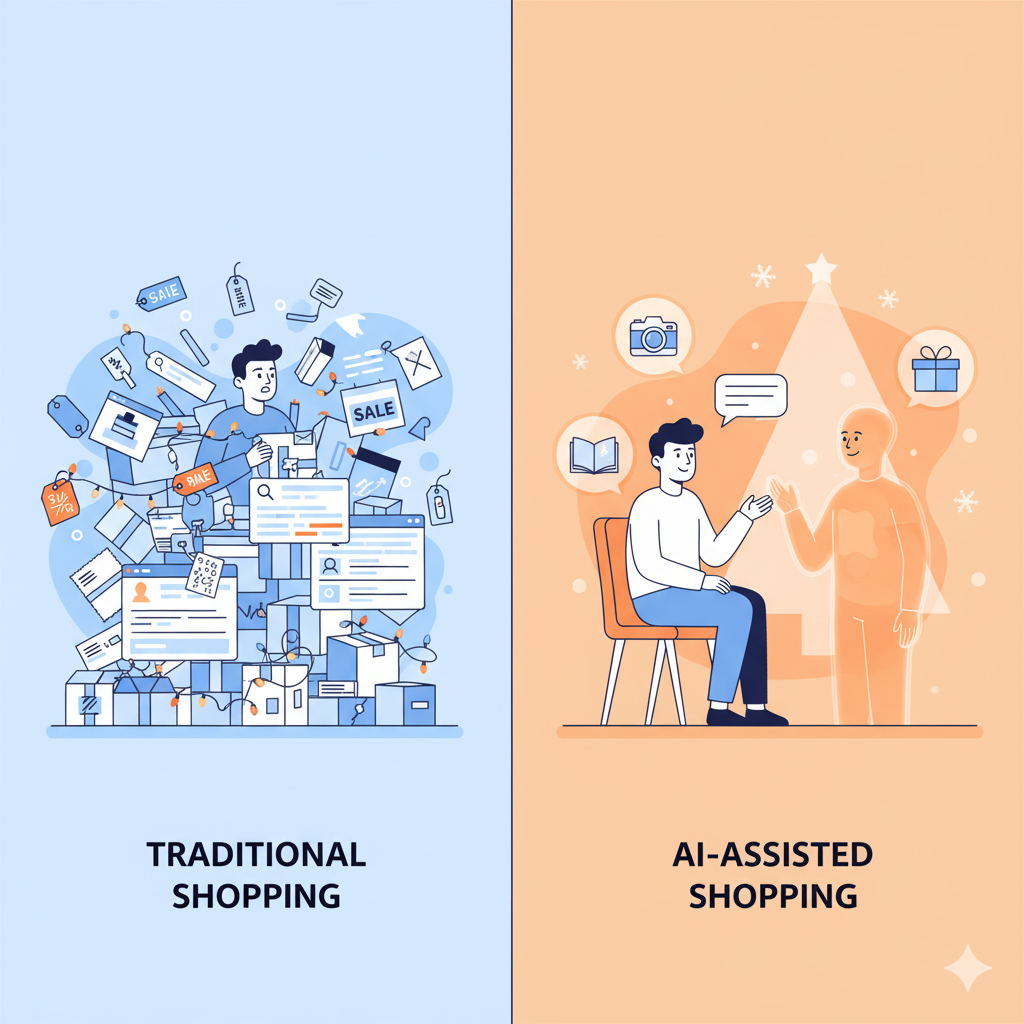
Every holiday season, a predictable chaos descends upon retail.
Shoppers, frantic for the perfect gift, drown in millions of products. Retailers, desperately trying to meet demand, wrestle with supply chain gremlins and mountain ranges of misplaced inventory. It’s a messy, high-stakes battle where friction costs billions.
But 2025 marks a pivotal shift. The AI shopping assistant is evolving from a simple chatbot to something far more sophisticated a skilled, increasingly personalized digital companion. This transformation isn’t just a new tool; it’s emerging as the rescue plan for an industry facing complex economic headwinds and increasingly demanding consumers.
The core promise of this new wave of AI? Clarity beats chaos.
1. The Death of Search Fatigue (The Customer Side)
Before, shopping was an act of hunting and filtering. A search for “best headphones for my brother” returned thousands of near-identical results. Now, AI agents are beginning to eliminate much of the friction in the discovery phase.
The Three Shifts Defining the AI Shopper
A. From Keyword to Conversation
Generative AI allows shoppers to describe intent and context, not just the product.
Old Search: “Waterproof headphones under $100”
AI Agent Query: “Find a great gift for my teenage niece who just started a swim team. I want something durable, good for Spotify, and nothing that costs more than what I spent on her birthday last year.”
The AI processes emotional context, budget constraints, and utility requirements, generating highly curated shortlists. Leading platforms are already demonstrating how this conversational approach drives significantly higher conversion rates than traditional search.
B. The Perfect Personalized Offer
Advanced AI systems analyze data at unprecedented speed, factoring in:
- Past purchases and style preferences
- Real-time inventory levels at nearby fulfillment centers
- Current competitive pricing across multiple retailers
The result is an increasingly dynamic, one-to-one shopping journey where recommendations feel custom-made, cutting through generic advertising noise.
C. The Emerging Autonomous Buyer
The next evolution is already beginning: early adopters are experimenting with AI agents as “shopping assistants” that can:
- Monitor prices on specific items and alert when thresholds are met
- Suggest automatic reordering of household staples based on usage patterns
- Source highly-rated alternatives when preferred items are unavailable
Many major platforms are rolling out these features, though adoption varies. This shift toward automated decision-making means brands must ensure their product data is structured and comprehensive enough for machine recommendation systems.
2. Inventory and Experience: The Retailer’s AI Advantage
The holiday season determines whether a retailer’s supply chain makes or breaks the year. AI assistants are addressing backend challenges the operational complexity customers never see.
| Challenge (The Chaos) | AI Solution (The Clarity) | The Commercial Impact |
|---|---|---|
| Forecasting Errors | Predictive demand modeling analyzing sales history, weather patterns, social trends, and economic signals for hyper-local SKU predictions | Reduces costly stockouts and minimizes post-holiday overstock |
| Customer Service Overload | Advanced chatbots handling routine inquiries (order status, returns, basic troubleshooting) with improved natural language processing | Human agents focus on complex, high-value problems, improving satisfaction and efficiency |
| Content Creation Bottlenecks | AI-powered content generation for product descriptions, SEO copy, seasonal imagery, and social media variations | Enables rapid deployment of personalized campaigns without lengthy production cycles |
This fusion of predictive analytics and automation is transforming the annual holiday scramble into a more manageable, profitable operation. Less emergency air freight, more strategic inventory allocation.
3. The Golden Rule of 2025 Retail
David Ogilvy famously said, “The customer is not a moron, she’s your wife.” The modern translation for the AI era is simpler:
The customer is not a search engine; she is a conversational partner.
The retailers succeeding in 2025 are using AI not to replace human connection, but to enhance relevance. They deploy agents to strip away noise irrelevant products, generic messaging, out-of-stock frustrations and deliver moments of perfect fit.
AI shopping assistants aren’t a threat to retail; they’re the antidote to holiday chaos. They represent a new force of clarity, ensuring that when shopping intensity peaks, the right gift connects with the right person at precisely the right moment.
Your Strategic Next Step 💡
The race to become “AI-ready” is accelerating. Is your brand’s product data the essential fuel for these emerging systems clean, comprehensive, and optimized for conversational discovery?
Call to Action: What’s the first shopping task you’d trust an AI assistant to handle this holiday season? Share your thoughts below and let’s explore how this technology evolution impacts your retail strategy.
Disclaimer: This blog post was generated with the help of artificial intelligence. Readers are encouraged to verify facts independently.


